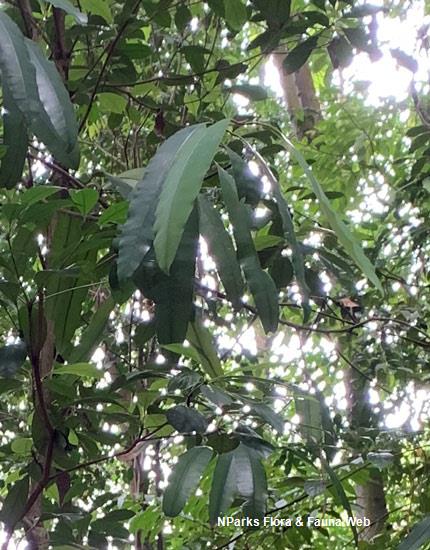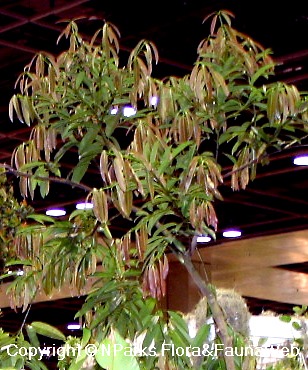
Back
Calophyllum rufigemmatum M.R.Hend. & Wyatt-Sm. ex P.F.Stevens
| Family Name: | Calophyllaceae |
| Synonyms: | Calophyllum wallichianum auct. non Planch. & Triana <1> |
Calophyllum rufigemmatum is a tree native to Singapore. Growing between 20 - 48 m tall, it has leathery, egg to almost elliptic shaped leaves and terminal buds which are prominent, appear narrowly conical to plump, covered in reddish brown, short fine to woolly hairs. Flowers are white, borne on an inflorescence of up to 7 in a cluster. The fruit is brown to greyish-brown, round to almost pear-shaped.
Name
Classifications and Characteristics
| Plant Division | Angiosperms (Flowering Seed Plants) (Dicotyledon) |
|---|---|
| Plant Growth Form | Tree (Medium (16m-30m), Big (>30m)) |
| Lifespan (in Singapore) | Perennial |
| Mode of Nutrition | Autotrophic |
| Maximum Height | 48 m |
Biogeography
| Native Distribution | Southeast Malaya, Singapore, Sumatra |
|---|---|
| Native Habitat | Terrestrial (Primary Rainforest, Secondary Rainforest) |
| Preferred Climate Zone | Tropical |
| Local Conservation Status | Native to Singapore (Endangered (EN)) |
Description and Ethnobotany
| Growth Form | It is a medium to tall sized tree that can grow between 20 - 48 m tall. The bark is grey to brown, deeply fissuered with clear, yellow, sticky latex. |
|---|---|
| Foliage | Leaves are egg to almost elliptic shaped, leathery, measuring 6.7 - 32.5 cm long and 2.2 - 7.5 cm wide. The leaves are held on a long slender petiole sometimes covered in short hairs. The terminal bud is generally elongated, narrowly conical to plump and prominent, 2.5 - 20 mm long, covered in reddish brown short fine to woolly hairs. Its secondary veins are numerous, very close together, straight and parallel, almost at right-angled to the midrib. The short hairs found on the twigs, petiole and midrib occasionally are usually on the underside, reddish brown in colour. |
| Flowers | Borne in an inflorescence at the axils, the white flowers are bisexual, in groups of 5 -7, short and clustered together. |
| Fruit | The fruit is round to almost pear-shaped drupe, brown to greyish brown with broad, ridges or fine wrinkles lengthwise when dry measuring 26 - 44 mm long by 24 - 32 mm wide. |
| Habitat | Occurs in mixed dipterocarp forest, on ridges, slopes and or other well-drained areas, 5 - 305 m in altitude. <2,3> |
| Cultivation | It can be propagated by seed. |
| Etymology | Its species epithet, rufigemmatum is made of the Latin words rufus meaning reddish; gemma translating to bud in reference to the reddish-brown buds. |
Landscaping Features
| Desirable Plant Features | Ornamental Flowers, Ornamental Foliage |
|---|
Plant Care and Propagation
| Light Preference | Full Sun |
|---|---|
| Water Preference | Moderate Water |
| Plant Growth Rate | Moderate |
| Rootzone Tolerance | Well-Drained Soils, Moist Soils |
| Propagation Method | Seed |
Foliar
| Foliage Retention | Evergreen |
|---|---|
| Mature Foliage Colour(s) | Green |
| Foliar Type | Simple / Unifoliate |
| Foliar Arrangement Along Stem | Opposite |
| Foliar Attachment to Stem | Petiolate |
| Foliar Shape(s) | Non-Palm Foliage (Elliptical, Ovate) |
| Foliar Venation | Pinnate / Net |
| Foliar Margin | Entire - Wavy / Undulate |
| Foliar Apex - Tip | Acute |
| Foliar Base | Acute, Cuneate, Oblique / Asymmetrical, Rounded / Obtuse |
Floral (Angiosperm)
| Flower & Plant Sexuality | Bisexual Flowers , Bisexual Flowers |
| Flower Colour(s) | White |
|---|
| Flower Grouping | Cluster / Inflorescence |
| Flower Location | Axillary |
| Flower Symmetry | Radial |
| Flowering Habit | Polycarpic |
Fruit, Seed and Spore
| Mature Fruit Colour(s) | Brown |
|---|---|
| Fruit Classification | Simple Fruit |
| Fruit Type | Fleshy Fruit , Drupe |
References
| References | <1> Hook, J.D. (1874). Calophyllum. Guttiferae, The flora of British India, vol. 1, pt. 2, pp. 273. London: L. Reeve & Co. <2> Hung, S.M.X, Seah, W.W., Chong, K.Y (2022), Towards a field guide to the trees of the Nee Soon Swamp Forest (VI): Calophyllum (Calophyllaceae). Nature in Singapore Suppl 1: 51-52. <3> Stevens, P.F. (1980). A revision of the old world species of Calophyllum (Guttiferae), Journal of the Arnold Arboretum 61(2): 352-354. |
|---|
Image Repository
Others
| Master ID | 29510 |
|---|---|
| Species ID | 3819 |
| Flora Disclaimer | The information in this website has been compiled from reliable sources, such as reference works on medicinal plants. It is not a substitute for medical advice or treatment and NParks does not purport to provide any medical advice. Readers should always consult his/her physician before using or consuming a plant for medicinal purposes. |

_lowres.jpg)
_lowres.jpg)

_lowres.jpg)
